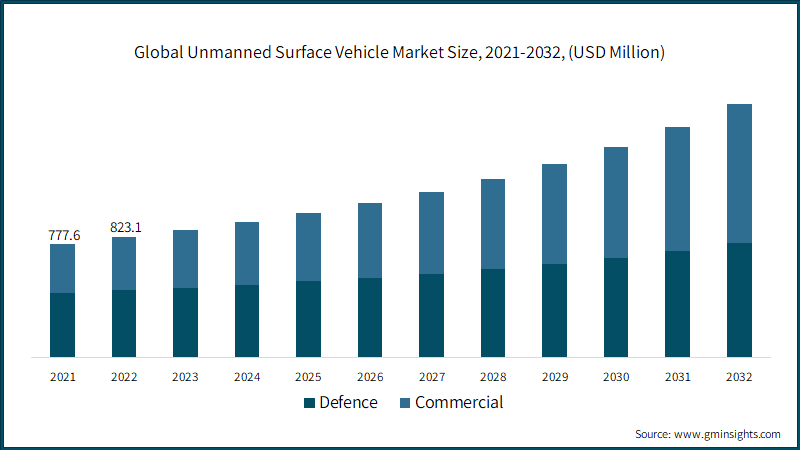Home > Aerospace & Defense > Unmanned Surface Vehicle Market
Unmanned Surface Vehicle Market Analysis
- Report ID: GMI5741
- Published Date: May 2023
- Report Format: PDF
Unmanned Surface Vehicle Market Analysis
Based on application, the defense sector segment held approximately 55% of the unmanned surface vehicle market share in 2022 and is expected to grow at a lucrative pace by 2032. The increasing demand for USVs in anti-submarine warfare and special operations by forces in critical missions, naval gunnery training, and firefighting & rescue operations will drive their adoption in the application areas. Market vendors are incorporating features that allow for real-time image transmission as well as remote visual verification and recording of evidence.
Based on system, the unmanned surface vehicle market is segmented into propulsion, chassis material, payload, component, software, and communication. The communication segment accounted for 100 million in 2022 and expected to grow a fastest rate. A communication system is an important component in a USV. The communication system helps USVs to collect and transmit real-time data enables authorities to make timely and informed decisions, increasing their popularity for maritime surveillance.
As a result, rising demand for maritime surveillance is propelling the segment forward, as USVs provide a cost-effective, efficient, and safe solution for monitoring and surveillance in the maritime industry. This increases the versatility and effectiveness of USVs for a wide range of applications including defense, scientific research, and environmental monitoring. A more efficient communication system allows the USVs to perform a broader range of tasks and missions.

Based on operation, the remote operated surface vehicle segment captured around 50% of the unmanned surface vehicle market share in 2022 and is anticipated to grow at a 5% CAGR through 2032. Remote-operated surface vehicles provide operators the ability to monitor them from remote locations. This ability helps operators to perform surveillance tasks at sea. Remote control, on the other hand, requires a stable, robust connection, which may be unavailable in an Electromagnetic (EM) contested environment, where communication signals may be blocked or reveal the ship's location. In this case, the system would either revert to autonomous controls or become a floating husk.

Asia Pacific unmanned surface vehicle market is poised to register gains at over 10% up to 2032, propelled by automation and robotics become more prevalent in various end-use industries. USVs are gaining popularity in the region due to their advantages, which include increased safety, lower operating costs, and the ability to operate in harsh environments. They are being used in a variety of industries including defense, oil & gas, transportation, and oceanographic research. The applications of advanced technologies, such as artificial intelligence and machine learning, are also propelling market growth in the Asia Pacific region.

